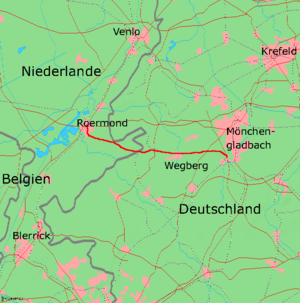Iron Rhine
The Iron Rhine (Dutch: IJzeren Rijn / German: Eiserner Rhein) is a freight railway connecting the port of Antwerp in Belgium to Mönchengladbach in Germany by way of Neerpelt and the Dutch towns of Weert and Roermond.
The Treaty of London between the Netherlands and Belgium in 1839 recognised the independence of Belgium. As part of the treaty, Belgium had the right to build a road or canal from Sittard to the Prussian border over Dutch territory, with Belgium funding the construction. This right was further established in the Iron Rhine Treaty of 1873. At first Belgium planned to dig a canal, but in the end it opted for a railway.
In 1868 construction of the Iron Rhine started, and in 1879 the first trains used the railway. At first, traffic was dense and frequent, but it decreased over time. Currently the railroad is used by some trains between Antwerp and the zinc factory in Budel, and between Budel and Weert. The line Weert - Roermond is part of the Dutch Intercity network, and is used daily by many trains. Between Roermond and the German border, traffic has fully ceased since 1991.
Reopening
In 2004 Belgium requested a reopening of the Iron Rhine. This is the result of the increasing transport of goods between the port of Antwerp and the German Ruhr Area. As part of the European policy of modal shift on the increasing traffic of goods, transport over railway lines and waterways is preferred over road transport.
Currently Belgium uses the Montzenroute, south of the Iron Rhine, for transportation of goods to Germany. High passenger traffic causes a lack of capacity for goods on this route, and a number of steep inclines over the route make it problematic for long and heavy trains.
The Belgian request is based on the treaty of 1839, and the Iron Rhine Treaty of 1873. Critics feel that Belgium cannot call upon these treaties, as in the treaty of 1873 Belgium had been granted a concession of 99 years on the Iron Rhine Railroad, a period which ended in 1972. Furthermore, Belgium has sold the railroad to the Dutch Government. The strongest argument is that the railroad runs through the nature reserve of De Meinweg, and nature activists fear destruction of the local habitat of several threatened species.
After a series of failed negotiations, the Belgian and Dutch governments agreed to take the issue to the Permanent Court of Arbitration and respect its ruling in the case. In its ruling of May 24 2005, the court acknowledged both the Belgian rights under the cessation treaty of 1839 and the Dutch concerns for the nature reserve. The 1839 treaty still applies, the court found, giving Belgium the right to use and modernize the Iron Rhine. However, it has to finance the modernization of the line, while the Netherlands have to fund the repairs and maintenance of the route. Both countries will split the costs of the construction of a tunnel beneath the nature reserve.
External link
- Project IJzeren Rijn (in Dutch)

